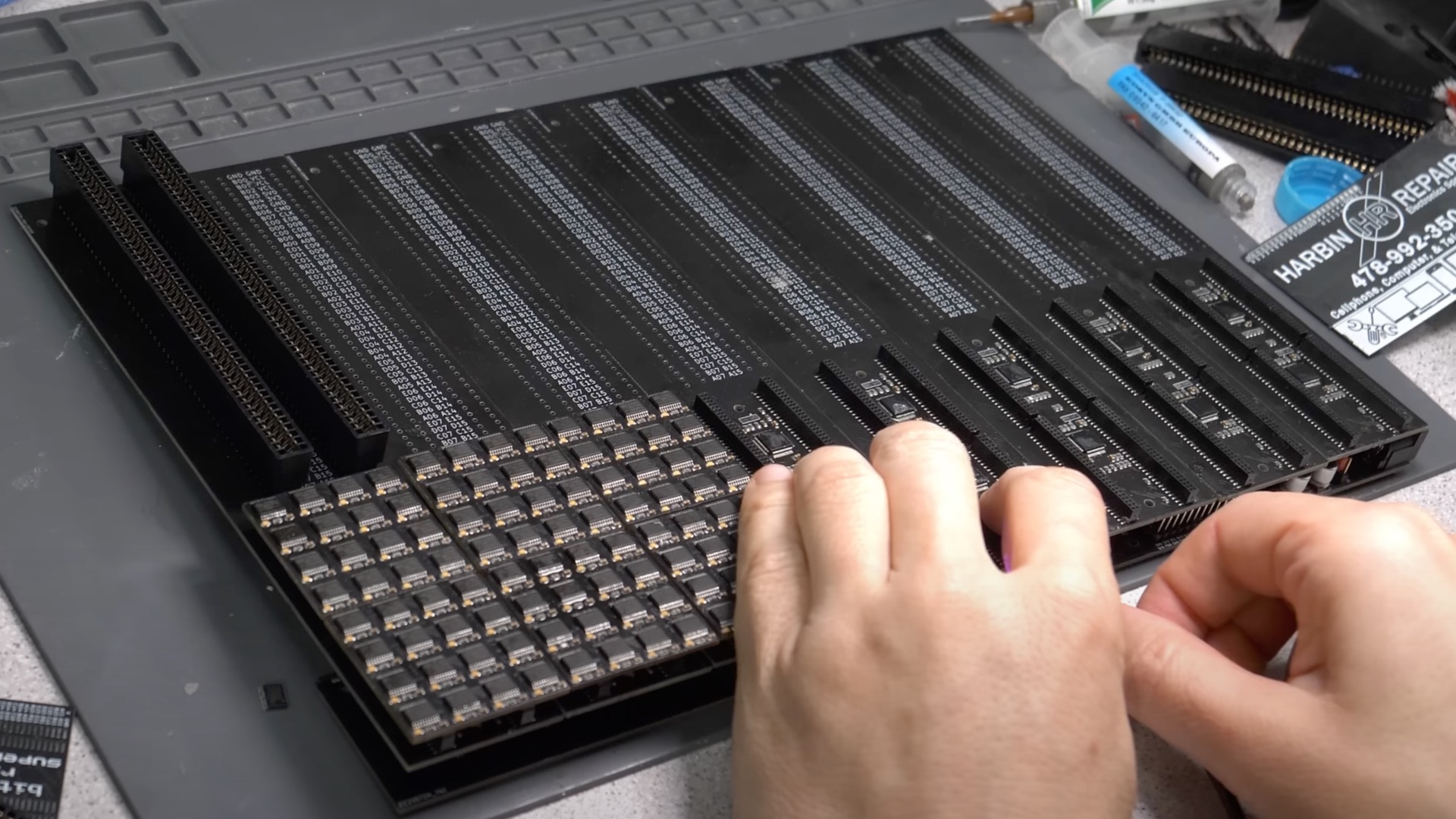YouTuber built a 256-core RISC-V megacluster because he could
A miniature supercomputer you build at home? Why not!

Tech gadget builder bitluni recently unveiled his latest build, a 256-core RISC-V megacluster. The YouTube content creator demonstrated the miniature supercomputer in a video that highlighted the design, production, assembly, and testing phases. Not everything went as planned, but the results are actually pretty nerdy and cool.
For the design, bitluni combined 16 RISC-V superclusters into a single megacluster. Each supercluster consisted of 16 CH32V003 RISC-V microcontrollers connected with an 8-bit bus. Each supercluster contains its own LED because bitluni wanted to be able to display a line of text.
To deal with potential problems inherent in building an extremely large (and power-hungry) single PCB for the megacluster, bitluni installed the superclusters in pairs on eight “cluster blade” designs. The inventor used two additional CH32V203 microcontrollers on each blade to serve as a bridge between each supercluster and the main 8-bit megacluster bus.
In the video, you can watch the assembly in time-lapse as bitluni attaches the microcontrollers to the PCB, solders the GPIO headers, and puts the entire megacluster together for testing. The blades all attach to a single main board, and as bitluni demonstrated first the LEDs blinking, he also found one of the mistakes he made in the design.
Without an internal clock source, bitluni discovered his LEDs blinked out of sync with each other. So, even though the lights initially blinked simultaneously, they quickly lost that synchronicity and flashed randomly. (Still, it’s almost hypnotic to watch.)
The creator went on to describe how to programmatically deal with bus collisions as all the microcontrollers talked at once.
Ultimately, bitluni’s megacluster used 256 RISC-V microcontrollers at 48 MHz and 17 RISC-V chips at 144 MHz. It includes 640 GPIO pins and 256 ADC circuits. He describes the 14.7 GHz combined single-core clock rate as "not that impressive but also not too shabby."
Considering bitluni designed and built a supercomputer that is small enough to sit on a TV tray, that description may be a bit of an understatement. Let’s also not forget that what he built cost far less than you would spend on even the used and leaky Cheyenne supercomputer.
Get Tom's Hardware's best news and in-depth reviews, straight to your inbox.

Jeff Butts has been covering tech news for more than a decade, and his IT experience predates the internet. Yes, he remembers when 9600 baud was “fast.” He especially enjoys covering DIY and Maker topics, along with anything on the bleeding edge of technology.
-
das_stig Imagine having a consumer motherboard that you could just plug in multiple riser cards all hosting multiple low cost, low power efficient (ie instant zero power sleep mode when not needed) but very capable processors to create your own supercluster, maybe we can finally play Cyberpunk 2077 as it was envisaged to be.Reply -
oofdragon So... the article doesnt mention how much did it cost him and neither what are the practical uses to this megacluster. Like will it run linix, windows or what? Will it zip files faster than a Ryzen 7950X3D, will it give more gaming fps than it and etc?Reply -
Pierce2623 Reply
If you think the average consumer is ready for multiple CPUs, I get the impression you’ve never used a multiple CPU server. It would make much more sense to just give consumers access to more cores on consumer CPUs. If Intel or AMD would sell a consumer CPU with like 32-48 e cores and 64 pcie lanes for about $5-600, I’d snap it up in a second.das_stig said:Imagine having a consumer motherboard that you could just plug in multiple riser cards all hosting multiple low cost, low power efficient (ie instant zero power sleep mode when not needed) but very capable processors to create your own supercluster, maybe we can finally play Cyberpunk 2077 as it was envisaged to be. -
Pierce2623 Reply
I guess it should at least run Linux since it’s risc voofdragon said:So... the article doesnt mention how much did it cost him and neither what are the practical uses to this megacluster. Like will it run linix, windows or what? Will it zip files faster than a Ryzen 7950X3D, will it give more gaming fps than it and etc? -
DougMcC Reply
It will probably not compete with the Ryzen on anything. Even if IPC were equal, it doesn't deliver nearly as many cycles as that Ryzen. Plus you have to deal with trying to scale whatever you are running across that many cpus, and very few things will scale perfectly across quite that many cpus.oofdragon said:So... the article doesnt mention how much did it cost him and neither what are the practical uses to this megacluster. Like will it run linix, windows or what? Will it zip files faster than a Ryzen 7950X3D, will it give more gaming fps than it and etc? -
das_stig Socket motherboards like dimm slots are old world, the idea of a motherboard with slots that just fill with daughter boards with whatever cpu, gpu, npu or memory or whatever or mixture of all of them is what we should be aiming for, sort of going back to the old school days of everything being a plugin card, memory, fpu, x86 board.Reply -
bit_user Reply
None.oofdragon said:So... the article doesnt mention ... what are the practical uses to this megacluster. Like will it run linix, windows or what? Will it zip files faster than a Ryzen 7950X3D, will it give more gaming fps than it and etc?
No, no.
No.
No.
If these chips weren't so primitive, you might be able to do some interesting realtime signal processing with them. That's something people did with these sorts of architectures, in the past. Much beyond that, such an architecture is too hard to program and doesn't run off-the-self software, so real-world applications would be very limited.
But I did say if. The article mentions these are just microcontrollers, although they do have floating-point, apparently. Still, they probably just have in-order, single-issue scalar pipelines and don't support external DRAM, much less a full-blown OS kernel. -
bit_user Reply
In a mere 64 kB of SRAM? No.Pierce2623 said:I guess it should at least run Linux since it’s risc v
https://github.com/openwch/ch32v307These are just 32-bit microcontrollers. They don't even support external DRAM. They're meant for embedding in small appliances and IoT sorts of things. -
lvt Replydas_stig said:Imagine having a consumer motherboard that you could just plug in multiple riser cards all hosting multiple low cost, low power efficient (ie instant zero power sleep mode when not needed) but very capable processors to create your own supercluster, maybe we can finally play Cyberpunk 2077 as it was envisaged to be.
I remember having seen such motherboard, it's used for Bitcoin mining. -
Pierce2623 Reply
Then what’s even the point if there’s no OS? You can use microcontrollers as a cpu though. Look at the Raspberry Pi Zero. It’s sold as a microcontroller. If this thing literally only blinks LEDs then I’ve never seen something this stupid.bit_user said:In a mere 64 kB of SRAM? No.
https://github.com/openwch/ch32v307These are just 32-bit microcontrollers. They don't even support external DRAM. They're meant for embedding in small appliances and IoT sorts of things.
